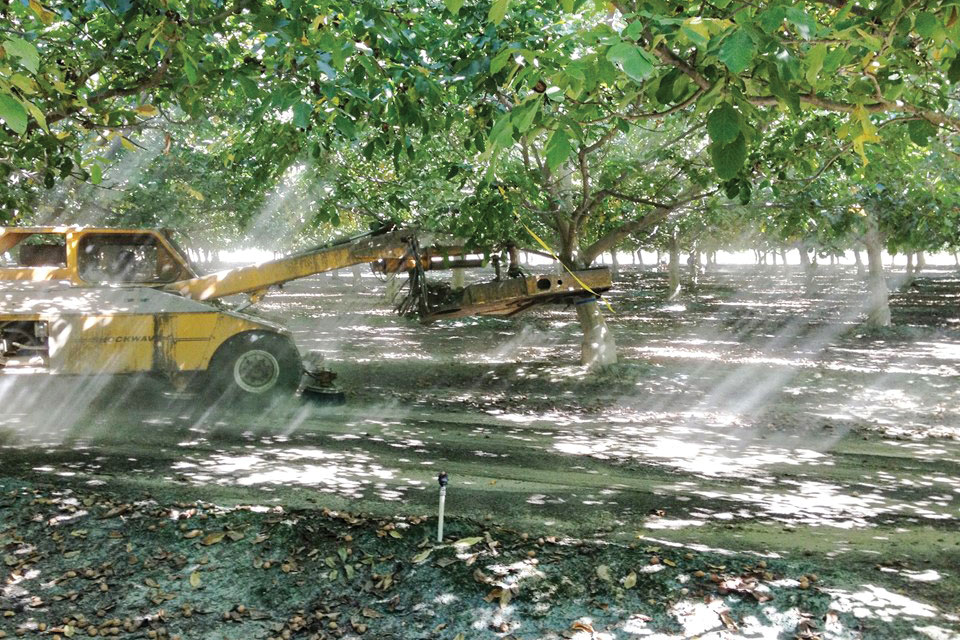How to Optimize Walnut Nitrogen Uptake

Katherine Jarvis-Shean, University of California’s Cooperative Extension area orchard systems adviser for Sacramento, Solano, and Yolo counties, says nut size may be reduced if walnuts do not get enough chilling hours in the off-season. (Photo: Katherine Jarvis-Shean)
Making sure walnut trees get enough nitrogen without spending a great deal requires closely accounting for an orchard’s seasonal use. Growers should note the moisture content, makeup of the soil, and anticipated yield of an orchard each and every year.
“You’re looking to start providing the trees with nitrogen the first month after leaf-out. The trees are not taking up nitrogen before then. If you start giving them nitrogen before that, you risk nitrogen getting leached out of the soil by the spring rain. The goal is to keep the nutrients in the root zone for as long as possible,” says Katherine Jarvis-Shean.
Jarvis-Shean is the University of California’s Cooperative Extension area Orchard Systems Adviser for Sacramento, Solano, and Yolo counties.
Heart of Nutrition
Mid-July, Jarvis-Shean says, is the best time for leaf sampling to assess a walnut tree’s nutrient status.
“[Later in summer] is when the leaves get leathery and waxy. When the leaves are tough, it’s harder for micronutrients to get into the leaves. You can’t really recover from micronutrient deficiency late in summer. It’s more about doing it right the next year,” she says.
Nitrogen is inexpensive, but growers need to apply it in multiple, small doses. This optimizes efficient nitrogen uptake and helps avoid nitrate leaching. Fertigation is the easiest and most effective application method.
“The concern is that the systems are expensive. Also, you want to move away from older, cheaper systems like flood sprinklers to solid-set sprinklers and micro- sprinklers. These offer more control to apply water in the root zone,” says Jarvis-Shean.
To shoulder the expense efficiently, growers should ready themselves to adopt fertigation. They should buy the sprinkler system that suits their needs when they plant new trees.
“Walnut orchards are a 25- to 30-year investment. Often, growers don’t change the infrastructure of an orchard once it’s in place. Today, a lot of newer walnut orchards are better set up for fertigation. It’s going to take some time for the industry as a whole to utilize this method of application,” says Jarvis-Shean.
Wet Winter and Spring
The winter of 2018 and spring of 2019 proved to be extremely wet. The rains required that growers wait to apply nitrogen until May. Tractors could not effectively spread broadcast fertilizer on wet ground.
Compacting soil when the ground is wet can impact the roots, Jarvis-Shean says. The cooler spring also impacted the start of the season as “trees take longer to leaf out when it’s cold,” she says.
Understanding Your Soil
Joe Grant, Director of Research for the California Walnut Board, says California is home to 350,000 bearing acres of walnut trees. Jarvis-Shean further clarified that acreage is located mainly in the Central Valley.
“The main cultivar is ‘Chandler.’ ‘Howard’ and ‘Tulare’ are tied for second place. ‘Solano,’ ‘Durham,’ and ‘Ivanhoe’ run a far third behind. There are very few older varieties like ‘Hartley’ planted now,” says Jarvis-Shean.
Jarvis-Shean says different varieties of walnut trees take up nitrogen to about the same extent.
“What is more of a concern is running a nitrogen deficiency for several years. Ideally, you should take samples every year, so you won’t have any surprises,” says Jarvis-Shean.
Grant says understanding the soil helps a great deal.
“You generally see walnuts in somewhat heavier textured soils than almonds and pistachios. Walnuts are susceptible to poorly drained situations. They prefer deep- and medium- to finer-textured soils,” says Grant. “The heavier-textured soils are less prone to leaching than sandy [ones].”
One concern that nitrogen cannot address is climbing temperatures. If walnuts do not get enough exposure to cold in winter temperatures, nut set may be reduced, and nut size may be variable at harvest time.
“We are acutely aware of changing weather conditions in walnut-growing regions in California. Providing enough nitrogen and ensuring the trees take it up does not change the need for cool, winter temperatures,” says Grant.










